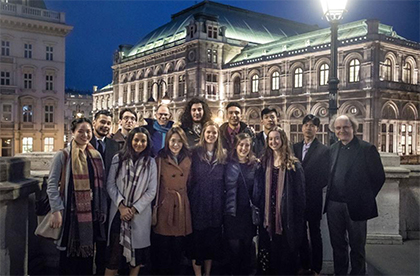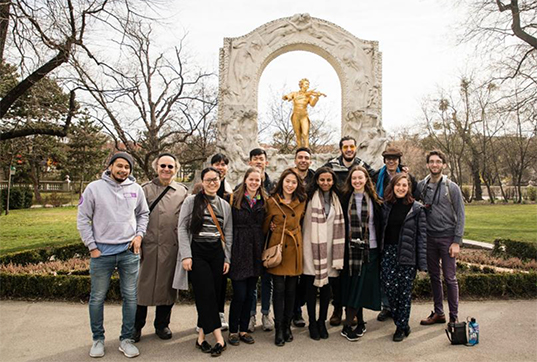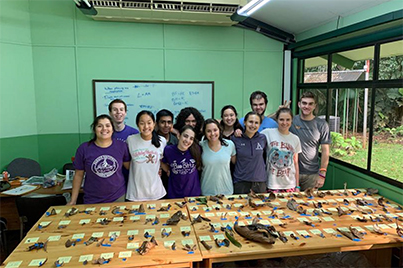
To cap off a semester studying pilgrimage traditions, Spanish lecturer Carmen Granda took a dozen Amherst students on a springtime visit to Spain, where they hiked 60 miles along a pilgrimage route to the Cathedral of Santiago de Compostela—the spot where, legend has it, the bones of St. James are buried.

In Austria (above and below), students went to symphonies.
Another 12 students saw Vienna through its music halls and opera houses, in a culmination of the course “Vienna: City of Music,” co-taught by a German professor, Christian Rogowski, and a music professor, David E. Schneider. On Tuesday, they heard Wagner; Thursday, Mozart; and Saturday, back-to-back Mahler symphonies. In between were waltz lessons and a visit to the Jewish Museum.
The two trips—fully funded by the College, including through endowed funds for student and faculty research—are part of a new program of course-specific travel, where students go deeper into their studies while also making new friends. This initiative paid to send students to Costa Rica and Colombia over winter break, and to Istanbul, Puerto Rico and England’s Lake District last year.

“They get to see a dry forest, and a cloud forest, and a rainforest. All the while, they’re staying in remote and rustic places,” says Ethan Clotfelter, professor of biology and environmental studies, of the 12 students he brought to Costa Rica for a tropical biology seminar with Rachel Levin, senior lecturer in biology and environmental studies. They started on the Pacific coast, traveling eastward over the Continental Divide, stopping at three biologically distinct habitats.
The Colombia trip—organized by Javier Corrales and Sebastian Bitar of political science—was the final project for their fall classes “The Political Economy of Petro States” and “Foreign Policy Analysis,” respectively. They spent a week in the port city Cartagena. Their itinerary also included visits to an Afro-Colombian community and one of the largest oil refineries in South America. The students even had dinner with a Venezuelan opposition member.
“It represents the perfect complement to the courses we take here at Amherst,” says Ryan Yu ’22, who took part in the Colombia trip, “allowing us to look beyond the classroom and see how our ideas play out in real life.”
For Dean of the Faculty Catherine Epstein—whose office underwrites such trips as part of a broader initiative to encourage pedagogical experimentation—there’s a deeper agenda: “Each course is amazing in and of itself, with obvious intellectual benefits,” she says, “but, for me, it is actually the social part that is most compelling.” That is, the trips meaningfully bring together students from diverse backgrounds.

In Costa Rica, students studied biology.
It’s not enough, she maintains, to simply form a diverse student body and expect its members to learn from one another: “We have to do things to make it happen. That process of spending 24/7 together lets you get to know people. Students make friends they’d never expect to make.”
Or, in the words of Diana Daniels ’21, the benefit was “not only more insight on the country of Colombia and petro states but also the opportunity to see the history of a city and bond with a select few students in the class. There were eight students on the trip plus our two professors, and it was a perfect amount.”